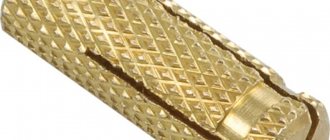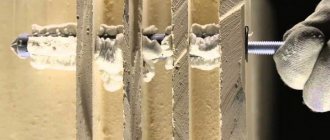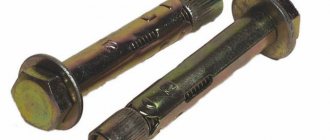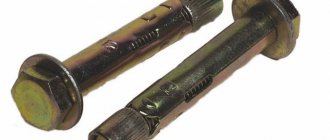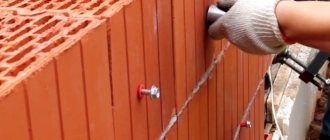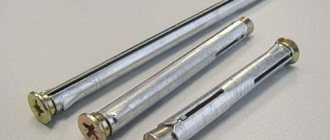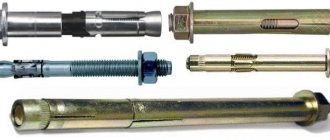Where and why is a drive-in anchor used?
The main feature of this anchor in comparison with analogues is the method of its installation. It involves wedging the sleeve during the process of driving a special rod into the fastener, whereas in other types of anchor elements it is assumed to be spaced by tightening the nut.
This design and operating principle provides the following advantages:
- High speed of installation using both hand tools (hammer) and pneumatic ones.
- The holes for such fasteners are shallow.
- Withstands quite high loads. However, the base for fastening must be very strong.
- Resistance to vibration loads.
Driving anchor diagram
Areas of application
A drive-in anchor, also called a collet, is successfully used to fasten the following types of structures:
- hanging furniture;
- hanging household appliances and equipment;
- bulky lamps;
- metal pipelines;
- other metal and wooden suspended structures.
The use of this type of anchors is advisable in foundations made of dense concrete, natural stone (non-porous), solid brick. At the same time, for brick foundations, drive-in anchors with a diameter of up to 8 mm are used.
Working of a driven anchor in stone
This is interesting: Aluminum U-shaped channel - characteristics and advantages
Drivers
A drive-in anchor is the simplest anchor-type fastener, the design of which consists of a spacer sleeve with a conical-shaped internal hole. To install such an anchor bolt at the required point in the building structure, it must be hammered into the mounting hole, and then a threaded element must be screwed into it, which will ensure the loosening of the bushing petals.
The material for the manufacture of such fasteners, the correct installation process of which can be seen in the video, can be galvanized steel or brass.
Attaching a drive-in anchor
Installation
Installing these mounts is a simple task, but requires care. To successfully complete the task, it is recommended to follow the scheme:
- Creating a small hole that will fit the size of the rod. For these purposes, an ordinary drill is used. The diameter of the hole should be such that the part fits in tightly;
- Cleaning the resulting opening. It is necessary to remove dirt and construction dust. For greater efficiency, you can use a vacuum cleaner or a medical bulb;
- Installing an anchor inside the opening;
- Driving the propping striker into the anchor. Can be done with a regular hammer;
If everything is done correctly, the split part of the part will expand in the walls of the opening. When the wedged anchor is properly fixed in the opening, you can screw a pin or bolt inside it and begin fastening the required object.
Preparing for anchor installation
Since classic drive-in anchors do not have seams, they are securely fixed. It is carried out directly due to mechanical deformation, and an ordinary hammer is sufficient to install the anchor.
- impact drill or hammer drill;
- drill with a diameter similar to the anchor;
- vacuum cleaner or thin long brush;
- hammer.
To install a drive-in anchor, you will need:
It is also important not to forget to buy an anchor of the load-bearing capacity you need and the optimal size. You can select a fastener with the required characteristics in our online store - if necessary, experienced consultants will help you make your choice.
How to make the right choice? Tips for masters
The design of these fasteners is standard. They may differ only in material and notches (available or absent). Craftsmen usually do not have any difficulties with which anchor to choose. However, let's look at a few simple tips.
Brass products can withstand minor vertical loads. Therefore, before purchasing, you need to consult the seller and find out how much weight they can withstand. In addition, the packaging always contains the necessary information.
The steel anchor is practical and easy to use. It is galvanized, which guarantees reliable protection against corrosion. Anchors made of this material allow you to attach almost any structure.
The material of the product also affects the price. Buying brass fasteners will cost a little more than conventional steel models, as they are resistant to corrosion.
As for notches, they are present on the outer surface of anchors made of any materials. They are in contact with the walls of the hole and contribute to obtaining high-quality and durable grip.
Models without notches have a smooth surface, so they are not able to withstand heavy loads. These fasteners are used to install items that are light in weight. They are suitable for installing oversized interior parts and objects made of wood or plastic.
How to properly secure a stud in concrete?
We are surrounded by hundreds of different materials, which from time to time have to be combined with each other. It is especially difficult to produce with those whose physical characteristics are completely different. In this article we will consider how to fix wood to concrete, in addition, we will touch on other materials. Any family expert will prove that most often during repair or construction it is necessary to combine timber and concrete. For example, to the foundation of a house when constructing a wooden building or when installing joists for a future floor, as well as performing work on cladding walls and ceilings. Everywhere we have to resolve one and the same problem - how to more reliably attach wood to concrete. How to attach timber to a foundation
Concept, purpose and use of anchor fasteners
An anchor is a type of fastener that is driven, screwed or inserted into the base and is capable of not only being fixed in it, but also holding an additional structure.
Translated from German, anchor means “anchor”. In terms of the way they act on the base, fasteners of this type really resemble an anchor - the working part of the anchor, when fastened, expands and holds the connection to the base.
Fasteners of this type are used when working with hard base materials - concrete, brick, natural stone. The anchor allows you to hold fairly massive structures or structures that are subject to dynamic loads, for example, plumbing fixtures, air conditioners, wall-mounted televisions, sports equipment, suspended ceilings, etc.
Expert opinion
Torsunov Pavel Maksimovich
The versatility and reliability of the anchor connection allows them to be used when working with other materials. For example, there are anchors for fastening in porous and lightweight materials, for connecting furniture elements. This type of fastening connection has found its application even in dentistry - an anchor pin is fixed in the root canal of the tooth and serves as a support for a filling or microprosthesis.
Four-segment
The design of such an anchor bolt does not include a wedge part, and the expansion of the spacer sleeve, divided into four segments by longitudinal slots, occurs when the bolt is screwed in, which moves the tetrahedral element in its internal cavity. The four lobes, which are formed by slots on the side surface of the spacer, are initially compressed and form the conical tip of such a bolt. When a bolt is screwed in, which moves a threaded tetrahedral element inside the spacer sleeve, the segments expand, which allows the anchor to be securely fastened in the mounting hole.
The fairly large expansion of the lamellas of this anchor ensures responsible fastening in various types of materials
The petals of such a product open quite wide and this happens very carefully. That is why it can be mounted in porous and even hollow materials. The threaded element, which is usually not supplied with such an anchor product, can be a bolt with a regular hex head or a bolt whose upper part is crowned with a ring or hook.
Installing a 4-segment anchor
Types of drive-in type anchors
Very often, experienced craftsmen call driven anchors in one word - collet . There are few types of them; basically, products can be divided according to the material from which they are made (steel and brass), and according to the available notches (available or absent). The steel product, according to the craftsmen, is one of the most practical and convenient to work with; moreover, it must be galvanized to protect it from corrosion. If brass is used for the manufacture of anchors, then the surface of the product will not require additional protective coating.
Driven-in brass anchors, like steel ones, are perfect for foundations made of natural stone, concrete, and brick. Such products are also used for fastening suspended structures, but when making this fastening, one must take into account the fact that it can withstand a small vertical load. When purchasing steel or brass drive-in anchors, you should immediately ask the seller what weight these products are designed for.
The packaging always indicates the size of the driven anchor and the calculated maximum load. The load for driven steel anchors should not be higher than 25 percent of the specified value, otherwise the attached structure may subsequently pull out of the base. When calculating the load, experts take into account the standard strength of concrete, that is, from 200 to 250 kgf/cm2; if this indicator is non-standard, then the permissible load must be calculated separately.
It is also important to consider that if the anchor is attached to a concrete wall that has cracks, then the permissible load (25% of the maximum) will need to be multiplied by another factor of 0.6. It is better not to allow a load higher than the obtained figure.
Hammer-in anchor with and without notches - fastening features
A hammer-in anchor with notches in appearance resembles a hollow cylinder with an internal thread. At one end of the cylinder there is a four-segment spacer zone. And on a certain section of the outer side of the anchor there are special notches, which are necessary for its reliable fixation in the prepared hole during installation work. The notched hammer anchor has long been noted by professionals as the simplest and most effective hardware product. With its help, you can always create a reliable and durable fastening, without the use of additional or special equipment.
The main advantages include the low cost of products, durability and strength. Manufacturers manufacture drive-in anchors using the latest equipment, resulting in good quality products at low prices. This product is especially often used in the construction of buildings, structures and various repair work. Notched anchors are used for mounting wall cabinets, grates, bars or slats, etc. If you need to attach heavy equipment, you can use multiple anchors. The main condition is to correctly calculate the load.
Driven-in anchors without notches are used for fastening lightweight structures. Their design is not very different from the model of notched anchors. They also resemble a cylinder, only the spacer side is smooth. Most often, such products are used if you need to create a permanent mount for any light decorative elements, light plastic structures, and the like.
Mode of application
It is also worth highlighting one significant advantage of the drive-in anchor (in addition to the high reliability of fastening). Namely, ease of installation. We can say that the installation of this mount can be carried out even by a non-professional.
Anchor bolts are driven according to the following algorithm:
- Drill a hole with certain dimensions at the base;
- Clean it (remove dust and other debris);
- Install the anchor into the hole;
- Using special tools (in particular, a hammer), hammer it into the conical hole;
- Use a bolt or pin to secure all parts.
Using a drive-in anchor makes sense when working with materials that are highly durable. In particular, we are talking about concrete.
Principle of operation
Anchor parts: outer sleeve with slots and spacer interact as follows:
- The spacer element is driven inside with a punch specially selected for its diameter.
- Moving in a given direction, the anchor pushes apart the split petals on the bushing body.
- Moving in the diametrical direction, the petals engage with the inner surface of the hole drilled in the wall. This ensures a secure fit.
- A screw is screwed into the threaded hole on the outside of the anchor, onto which the structure is hung.
Application of products
Fasteners are designed for use in dense materials:
- solid brick,
- dense heavy concrete;
- natural stone.
Fasteners are not used when fixing to:
- cellular and porous concrete,
- concretes with inclusions, like slag concrete,
- For brick walls, you can only use products up to 8 mm.
The exception is the Zikon drive-in anchor. For him, porosity and the presence of shells are not an obstacle.
Fastening elements can be:
- metal and wooden suspended structures;
- equipment;
- consoles, hanging furniture;
- cable ropes, lamps;
- can be used for mounting suspended structures on the ceiling, but taking into account the fact that the resistance to vertical load of the product is low. It makes more sense to limit yourself to wall mounting.
This video shows the installation process of a drive-in anchor:
Colors and size
In many cases, the size can be quickly and easily selected thanks to the color:
- Yellow - diameter 5 mm, length 24 mm. They only work when installing small and light objects. They work with screws with a diameter of 3-4.5 mm. They can be used on thin surfaces;
- Red - diameter 6 mm, length 26 mm. Compatible with screws with a diameter of 3.5-5 mm;
- Brown - diameter 7 mm, length 30 mm. They are suitable for screws with a diameter of 4-6 mm;
- Blue - their average size is 8 mm, length 32 mm. In this case, self-tapping screws with a diameter of 4.5-6 mm are suitable;
- Gray - diameter 10 mm, length 36 mm. Suitable for dowels with a diameter of 5-8 mm.
Permissible loads
Working loads of all types of anchor fasteners should be no more than 25% of the maximum pull-out load when used in concrete with a strength of 200-250 kgf/cm
2
(corresponds to concrete grades M200 and M250). As the strength of concrete increases, the recommended load of fasteners increases proportionally. If there are cracks in the concrete, the pull-out load is multiplied by a factor of 0.6.
Classifications
Anchors are classified according to service life:
By size, fasteners are divided into:
- Small (up to 5.5 cm long and up to 0.8 mm in diameter).
- Medium (up to 12 cm long and up to 1.2 cm in diameter).
- Large (up to 22 cm long and up to 2.4 cm in diameter).
According to the base material, anchors are distinguished:
- For dense concrete, brick or stone materials.
- For hollow brick and concrete foundations.
- For sheet materials - plasterboard, chipboard and fibreboard.
According to the method of fastening, the following are distinguished:
- Mechanical
Fastening is carried out due to the direct mechanical effect of the working part of the anchor on the base (wedging, friction, stop, material resistance, etc.).
- Chemical
Additionally, a gluing mechanism (force) is used; for fastening, adhesive based on polyester resins is used.
What anchor do you use?
ChemicalMechanical
Mechanical anchors according to the technique of insertion into the base are divided into the following types:
- Wedges.
- Spacers.
- Hammers.
- Screw.
- Bushings.
- Expandable.
- Spring.
Spacers
Expansion anchors are a classic type of this type of fastener. They are a rod in the form of a bolt or pin with a cone-shaped end and an external element in the form of a sleeve, bushing or spring ring. The conical element, under the influence of the translational movement of the rod, expands the sleeve and secures the structure in the base.
Expanding
An expansion anchor consists of a threaded rod, which can be a bolt, stud or screw, and a sleeve consisting of 4 longitudinal petals with a spring ring and a cone nut on one side. When the rod rotates, the cone nut unclenches the sleeve petals, as a result of which the anchor expands and is secured in the base due to friction.
Wedge
Wedge fasteners are a long rod, at the end of which there is a deformation sleeve. After screwing the rod into the drilled hole, the sleeve petals expand. This type of fastener can withstand heavy loads.
Spring
Spring anchors are used when working with thin-walled bases, for example, when arranging the interior. Often, spring anchors are used as ceiling anchors and are equipped with a hook. The anchor is secured by unrolling the spring.
Screw
Screw anchors, or Molly bolts, are used when working with hollow structures with low load-bearing capacity - hollow brick, plasterboard, particleboard and fiberboard, etc. The Molly bolt is equipped with a special collet, which, when the bolt is tightened, opens and rests against material on the reverse side.
Bushing
Sleeve-type anchors consist of 3 or more elements, the main one of which is the collet - a spring split sleeve. The sleeve anchor design also includes a riving element and a threaded rod. When the anchor is twisted, the wedging element enters the collet and pushes it apart, thereby securing the fastener to the base.
Drivers
The basis of the driven anchor is a metal deformation sleeve with a conical hole, cuts in the body and internal threads. A firing pin is installed at the bottom of the sleeve. The sleeve is installed into the drilled hole manually or using an air gun. When the outer end of the sleeve is struck, it is deformed, after which a bolt or pin is screwed into the sleeve, necessary for fastening any object.
Main varieties
Modern manufacturers do not produce many varieties of hammer-type anchors, which are also called “collet anchors.” Thus, anchors of this type are divided into different types according to two main parameters:
- by material of manufacture: steel and brass;
- by the presence of special notches on the outer surface: with and without notches.
Driven-type anchors made of steel alloys are more affordable in terms of cost. Such products, in addition, are characterized by higher strength when compared with brass fasteners. However, the big disadvantage of steel drive-in anchors is that in order to give them corrosion resistance, their surface must be coated with protective compounds (for example, they must be galvanized). Brass fasteners do not require such procedures.
Technical characteristics of brass drive-in anchors
A brass anchor, like a similar product made of steel, is used for fastening objects on structures made of various building materials: brick, concrete, natural stone, etc. Meanwhile, it should be borne in mind that brass fasteners are not able to withstand significant vertical loads, since brass has sufficient high ductility when compared with steel alloys.
When purchasing drive-in type anchors (both steel and brass), you should definitely find out what maximum weight of the object being secured they are designed for.
You can obtain information about the dimensions of a brass or steel drive-in anchor, as well as the maximum load for which it is designed, by reading the information on the packaging. The load that will fall on the driven anchor should not exceed 25% of that indicated on the packaging. If you do not adhere to this requirement, then you cannot count on the reliability and durability of the fastening made using such a product. Specialists from companies involved in the production of fasteners of this type usually take into account the standard strength of concrete structures (200–250 kg/cm2), but if you are going to install an anchor in a structure made of a material that does not meet these standards, then the permissible load will need to be calculated separately ok.
Permissible loads on driven anchors
There is also a peculiarity in choosing drive-in anchors for concrete building structures that are already covered with cracks. In this case, the permissible load on such elements, which is 25% of the maximum permissible, must be additionally multiplied by a factor equal to 0.6.
Device and scope of application
Anchors driven into elements of building structures are products through which various objects, even those of significant mass, are secured to such structures. Unlike dowels, with which drive-in anchors are often confused, the latter have a more complex design, which allows them to provide the highest reliability of fastening. The main design element of such an anchor is a hammered element (which is why it is confused with a dowel), into which a pin or bolt is then screwed, onto which the object being fixed is fixed.
Dowel fasteners, which can even be made of plastic, are used to secure various light-weight objects in structures made of porous materials. Fastening objects when using dowel elements is done using screws that are screwed through into such elements. Despite the high efficiency and ease of use of these fasteners, they cannot be used to secure objects that are too heavy, since they will not provide the required fastening reliability.
The structural elements of a hammer-in type anchor are:
- a metal sleeve with special slots on the side surface;
- a sleeve that is located on the spacer element;
- directly the spacer element itself.
Drive-in anchors vary in size
Depending on the purpose, anchors of this type can be made of high-strength metal or ordinary carbon steel. The surface of such products can be subjected to additional processing, which can reliably protect them from corrosion and extend their service life. The brass anchor is also very popular, characterized by its fairly high strength and exceptional resistance to aggressive environments. In addition, the brass anchor has high ductility, which greatly facilitates the installation of such fasteners.
To ensure high strength and, accordingly, reliability of drive-in type anchors, they are made of solid material. The elements from which they are made do not contain welded joints. The internal threaded hole in hammer-type anchors has a conical shape, and slots are made on their side surfaces, which are subjected to special processing. Such slots on the side of the driven anchor are necessary in order to form petals that act as spacer arms.
Drive-in anchor with wedge
At the moment when a spacer element is introduced into the inner part of the anchor, it acts on the walls of the conical hole, and the petals unclench, ensuring reliable adhesion of the fastener to the structure in which it is placed. Considering the fact that spacer elements of an anchor of this type create significant pressure on the internal walls of the hole, it is recommended to use such products for fastening various objects on structures made of dense and durable materials (concrete, natural stone, etc.).
Chemical
Chemical anchors are a type of fastening elements that, in addition to frictional force and material resistance, also use adhesive force through the use of synthetic resins.
This provides additional fixation. Chemical fasteners are used when securing particularly heavy structures or when working with porous and soft materials.
Expert opinion
Torsunov Pavel Maksimovich
The chemical anchor is usually a standard stud. After drilling the hole, its walls are blown out and covered with adhesive, after which the anchor is inserted. The disadvantage of chemical anchors is that they cannot be used immediately; you must wait until the adhesive reaches maximum strength.
Wedge
An anchor of this type, the spacer or wedge sleeve of which has a shortened length, is also a modification of a fastener with a nut. The wedge element that expands such a bushing is the reverse end of the threaded part of the bolt, which has a conical shape.
The drilling depth for this anchor must be greater than the minimum anchoring depth indicated in the technical specifications
The big advantage of using wedge-type anchor bolts is that for their reliable fastening there is no need to maintain the exact diameter of the mounting hole; moreover, it does not need to be cleaned of construction dust. Such a bolt is secured in the mounting hole, and its spacer element is expanded by tightening the nut.
In land management
Anchor products made of plastic have found application in land management and are used to strengthen banks, construct road embankments and pipelines.
Fastening elements have increased impact resistance and frost resistance, and are able to withstand the effects of groundwater, hazardous chemicals and corrosion.
Plastic fasteners are T-shaped and range from 60 to 120 centimeters in length. When driving into the ground and installing the ATP clip, the fastening elements are connected by a polymer cable and form a three-dimensional geogrid.
Dental anchor pins
Anchoring is also used in dentistry for endodontic treatment and dental prosthetics. Reinforced pins, manufactured in accordance with the anchor system, are placed inside the root canal of the tooth and strengthen the root of the tooth and its visible part. Thus, tooth prosthetics occurs, preventing bacteria from accessing the root system and resisting mechanical stress that can destroy the tooth.
A dental pin is attached to a tooth like an anchor and comes in several types:
- Active - they form a groove on the channel stacks due to the presence of threads; fastening occurs due to friction.
- Passive - attached using fixing cement.
- Semi-active - fastened with cement and threads on a limited part of the pin.
